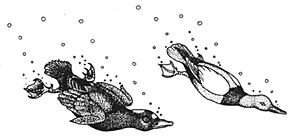Swimming |
|||
|---|---|---|---|
|
One
of the most graceful sights in the animal world is a penguin
swimming underwater. With seemingly no effort, they rocket
around using their wings to "fly" through the ocean.
Swimming penguins change the angle of the leading edge of
their wings, lowering them on the downstroke and raising
them on the upstroke, so that both strokes propel the bird
forward, resulting in smooth progression through the water.
The penguins' body feathers are short, and thus trap little
air, and their bones are quite solid for birds. Both
features reduce buoyancy, thereby helping penguins to remain
submerged. Underwater "fliers" are mostly seabirds with short wings, including cormorants, guillemots, auks, shearwaters, and diving petrels. To work well in water, wings must |
||
| be short and muscular. Long,
slender wings are fine for soaring, but are poor instruments
for flying in a medium as thick as water -- they cannot be
moved rapidly against the friction. But with their stubby
wings, underwater fliers tend to make poor aviators, and
some, such as penguins, have given up flying altogether.
Diving petrels, however, fly reasonably well with rapid wing
beats, and upon plunging into water simply continue to fly
through it. Most birds that swim in fresh water propel themselves with their feet. This is also true for underwater fliers when they are on the surface. The most advanced practitioners of this technique are the loons. Veritable submarines, loons are long, slender, and streamlined, with two powerful propeller-like legs attached to the rear of their body and tipped with webbed feet. Like penguins (and other diving birds such as auks, grebes, and cormorants) they have relatively solid bones and float low. And, like submarines, they can dive deep; Common Loons have been recorded at depths of 600 feet in the Great Lakes. Other birds that dive but are also accomplished fliers, such as terns, gannets, and pelicans, are quite buoyant because of their hollow bones, numerous air sacs, and the air that remains trapped in their feathers. They turn the trick of submerging much as buoyant human beings often do -- by diving from a considerable height and allowing their momentum to help carry them well below the surface. Kingfishers seem to use a similar technique, but often take their prey very close to the surface. In contrast, grebes can squeeze much of the air out of their feathers, and partially deflate their air sacs, "trimming" themselves to float at any level or to submerge. Cormorants and Anhingas have wettable feathers which help them sink but which also apparently commit them to long sessions of sun-drying with spread wings. Birds that are foot-propelled in water generally hold their wings tightly while diving and swimming, so as to streamline the body. Eider and scoter ducks, however, keep their wings partially open and use them for both paddling and steering. Oddly, the American Dipper often just walks along the bottom. When suspended in midwater, however, these passerines use their wings to swim. |
|||
| SEE:
Soaring;
Feet;
Spread-Wing Postures. Copyright ® 1988 by Paul R. Ehrlich, David S. Dobkin, and Darryl Wheye. |
|||
